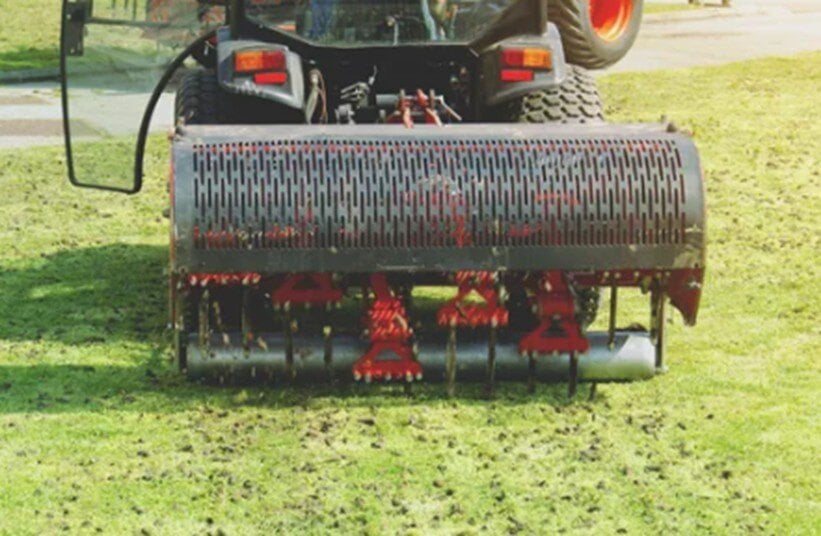At Lush Lawn, we understand that achieving a vibrant, healthy lawn requires more than regular mowing and watering. One crucial, yet often overlooked, practice is lawn aeration, a process that alleviates soil compaction, enhances nutrient absorption, and promotes robust root growth. By integrating aeration into your lawn care regimen, you can transform your yard into a lush, resilient landscape.
Key Takeaways
- Aeration relieves soil compaction, allowing roots to access essential nutrients.
- It enhances water infiltration, reducing runoff and promoting deeper root growth.
- Aeration helps manage thatch buildup, preventing pest and disease issues.
- The optimal timing for aeration depends on grass type and local climate.
- Combining aeration with overseeding can significantly improve lawn density and health.
Understanding Lawn Aeration
Lawn aeration involves perforating the soil with small holes to facilitate the penetration of air, water, and nutrients to the grassroots. This practice is particularly beneficial for lawns suffering from soil compaction a condition where soil particles are pressed together, reducing pore space and hindering root development.
Importance of Aeration to Achieve Maximum Lawn Health
Aeration plays a fundamental role in building and sustaining a healthy lawn. By loosening compacted soil and creating pathways for air, water, and nutrients to reach the root zone, aeration strengthens root systems and boosts overall turf resilience. It not only improves nutrient uptake but also helps manage thatch and reduces surface runoff, resulting in thicker, greener, and more vigorous grass. Without regular aeration, lawns often struggle with shallow roots, disease vulnerability, and poor drought tolerance challenges that can undermine long-term lawn health.
Benefits of Aeration
Alleviating Soil Compaction
Compacted soil restricts root expansion and limits the availability of essential resources. Aeration mitigates this issue by creating space for roots to grow deeply, resulting in a more resilient and drought tolerant lawn.
Enhancing Water and Nutrient Uptake
Aeration improves the soil's ability to absorb water and nutrients, reducing runoff and ensuring that these vital elements reach the root zone. This leads to more efficient use of fertilizers and irrigation, promoting overall lawn health.
Managing Thatch Accumulation
Thatch a layer of organic matter that accumulates between the soil surface and the grass can impede water infiltration and harbor pests and diseases. Aeration helps break down thatch by introducing soil microorganisms to the surface, facilitating its decomposition and maintaining a balanced thatch layer.
Optimal Timing for Aeration
The timing of aeration is critical and should align with grass type and local climate conditions.
For cool-season grasses found in Michigan such as Kentucky bluegrass and fescue, the ideal time to aerate is during the fall. This period allows the grass to recover and establish strong roots before winter dormancy.
Aeration Techniques
There are several methods to aerate a lawn, each suited to different soil conditions and lawn care goals.
Core Aeration
This method involves removing small plugs of soil from the lawn, effectively reducing compaction and promoting root growth. Core aeration is widely regarded as the most effective technique for most soil types.
Spike Aeration
Spike aeration uses solid tines to puncture the soil without removing any material. While this method is less effective at alleviating compaction, it can be suitable for sandy or loamy soils that require less intensive aeration. However, it's important to note that spike aeration may not provide the same long-term benefits as core aeration.
Combining Aeration with Overseeding
Pairing aeration with overseeding the process of spreading grass seed over an existing lawn can significantly enhance lawn density and fill in bare spots. The holes created by aeration provide an ideal environment for seed germination, leading to a thicker, more uniform turf.
Recognizing the Need for Aeration
Certain signs indicate that a lawn may benefit from aeration:
- The soil feels hard and compacted, making it difficult for water, air, and nutrients to penetrate into the root zone.
- Water tends to pool on the surface or run off quickly after rainfall, indicating poor absorption and soil compaction.
- Grass appears thin, weak, or shows bare patches, often due to limited root growth and restricted nutrient access.
- A thick layer of thatch has developed between the grass and soil, preventing essential elements from reaching the roots.
If these symptoms are present, aeration is a highly effective way to restore soil structure, improve root development, and promote long-term lawn vitality.
Conclusion
Incorporating aeration into your lawn care routine is a proactive step toward achieving a lush, resilient yard. By understanding the benefits and optimal practices associated with aeration, you can ensure that your lawn remains vibrant and healthy throughout the year. At Lush Lawn, we specialize in providing professional services tailored to your lawn's specific needs. Contact us today to schedule a consultation and give your lawn the care it deserves.
FAQs
- What are the signs that indicate a lawn needs aeration?
A lawn that feels compacted underfoot, shows puddling after rainfall or has thinning and patchy grass may be experiencing soil compaction or excessive thatch. These conditions suggest that aeration is needed to improve root access to air, water, and nutrients.
- When is the most effective time to aerate a lawn?
The ideal timing depends on the grass type. Cool season grasses respond best to aeration in early fall.
- Is it better to aerate a lawn personally or hire a professional?
While aeration can be performed using rented equipment, professional services offer precision, consistency, and tailored solutions using advanced tools. This ensures optimal results across all soil and grass types.
- How frequently should lawn aeration be performed?
Most lawns should be aerated once per year, especially in high-traffic areas or with clay-heavy soils. For lawns with naturally loose or well-draining soil, aeration may only be needed every 2 to 3 years.
- Is watering necessary after aeration?
Absolutely. Post-aeration watering aids in soil recovery and supports seed establishment if overseeding is also performed. It ensures that moisture and nutrients penetrate effectively into the newly opened soil.
